
|

|
Forum Index : Microcontroller and PC projects : The TermMite is (re)born . . .
| Page 1 of 2 |
|||||
| Author | Message | ||||
| WhiteWizzard Guru Joined: 05/04/2013 Location: United KingdomPosts: 2960 |
Hello all, As some of you are aware, last year I was working on a customised version of Geoff's VT100 module; which at the time I nicknamed 'The TermMite'. Due to limited interest I parked the project and focussed on other things; however in the background I knew it needed to be a much 'better' offering if people were going to use it. So after several months of development the TermMite is reborn. It is being shown below as part of a much bigger project I am currently working on; a kids computer (an example of just how the TermMite may be useful). Please can I ask that you take a few minutes of your 'BackShed' time so that I can receive as much feedback as possible. I am about to hand-over the kids computer to my customer but want to see if I have missed anything 'obvious'!! 
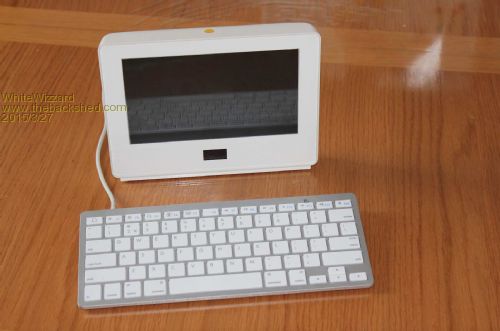
As seen here, the TermMite comprises of a free-standing screen (a very readable 8" TFT) and a slim & compact keyboard (modified to be PS2). Note the lack of a power cable, yes this is a fully portable, battery-powered setup (however, a 'mains' powered version will also be available). The small 'screen' underneath the TFT is a bi-coloured OLED upon which is displayed battery status; as well as other information. 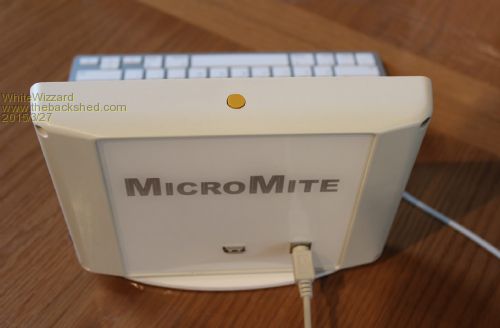
A single power switch mounted on the top side turns the unit on and off (long press to toggle between on and off). It also acts as a 'trigger' (short press) to show current battery status on the OLED (the OLED automatically switches off after a short while). Audible feedback is provided by an inbuilt piezo. On the back there are just two connectors - one for the wired PS2 keyboard, and the other to connect to a MicroMite/ArmMite. So just to emphasise here that the TermMite does not contain the MicroMite - think of it as a intelligent, colourful & portable 'TeraTerm' unit. (The 'MicroMite' name on the back panel may seem mis-leading but it is what is being proposed for the kids computer). A huge advantage to the TermMite is that it is immediately ready to use the instant you switch it on. 
So simply connect this TermMite to ANY MicroMite/ArmMite that you have (via the console pins) and it will just work  . The TermMite also provides a 5v 500mA output which can be used to power the attached MicroMite/ArmMite. . The TermMite also provides a 5v 500mA output which can be used to power the attached MicroMite/ArmMite.
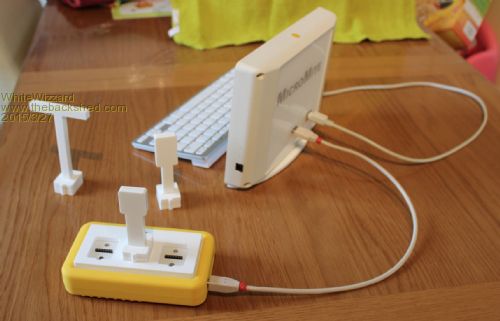
The yellow box shown above contains the actual MicroMite (28-pin MX170 in this case) and collectively form the kids computer. The yellow box in this setup is referred to as the 'I/O Box'. Into this are plugged various educational 'Modules' - here you can see the set of three 'Road Sign' Modules. 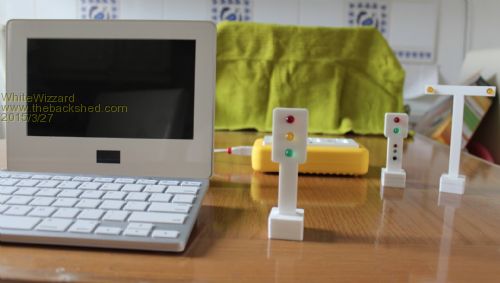
The 'Modules' are interchangeable and have been developed to progressively teach coding. The Modules use a self-alignment 'magnetic' connector mechanism that has been developed based upon user feedback - something these photo's don't do justice to! Anyway, that said, the I/O box and the Modules are not part of the actual TermMite! 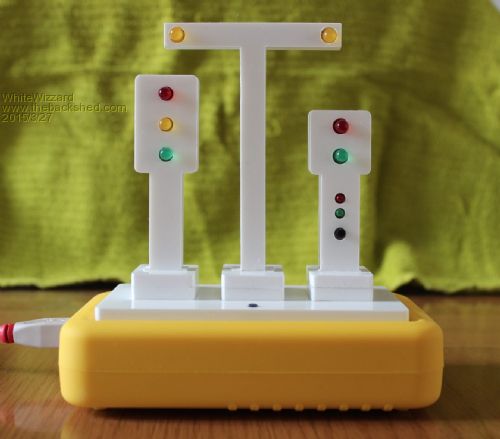
Many more educational Modules are currently under development but for now this is what is being trialled with children aged 7-11. These 'RoadSign' Modules teach the basics about coding outputs (LEDs), and inputs (Switches). All that is needed is just a couple of lines of code to immediately get results. Along with adding code for delays and loops then these Modules promote creativity by allowing the kids to program 'real-life' scenes. 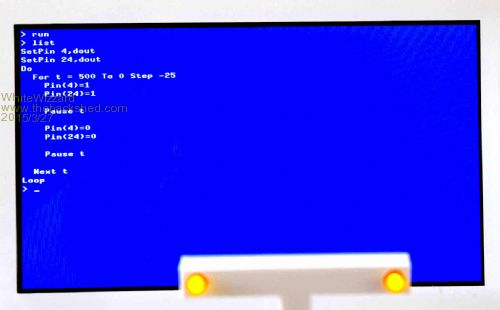
The TermMite incorporates basic file storage (currently a microSD mounted internally in the screen unit. I am working on an external SD card slot on the lower left hand side of the screen unit). This is work in progress but is not required for the kids computer (hence no photos shown here of the SD slot). As mentioned at the start of this long post, I am keen to get your feedback. I have been living, eating, breathing this project for almost six months now so I could be a bit 'blind' to some obvious things. So please do post me your valuable feedback - and dare I say, be as critical as you want!! All feedback will be taken on board and will hopefully allow me to 'tweak' the project before customer hand-over due in two weeks time. Thank you so much for your time to read this post (if you got this far); and also for your time to hopefully post me a response! 
Finally a big thanks to Geoff - we had a Skype call last year about this project and he was very supportive of the 'kids computer' idea. Thank you Geoff; and I hope you like what you see! . . . WW |
||||
| JohnS Guru Joined: 18/11/2011 Location: United KingdomPosts: 4164 |
First thoughts. I like it. Caveats... at least these... I'm not a child psychologist, educationalist, qualified teacher or ... well, you get the idea. You may find child psychologists (very possibly teaching at colleges etc) et al who'd be delighted to be asked for their comments in case you've not approached any as yet. I'm a bit concerned that the keyboard looks like it might be pesky to use. Can't tell from a pic, though. I'm guessing the modules align magnetically which sounds good. I'm hoping there are diodes etc so no (electronic) damage gets done no matter what. Following Dijkstra, maybe remove GOTO from MMBasic. I'm only half joking. In like manner, maybe add better (OK, any) data structures. Well, not absolutely needed for kids I suppose. But these 2 items (GOTO & data structures) are the Achilles heels of Basic. It looks headed in a much better direction to my unprofessional (re kids) eyes than that BBC thing (I now see that is aimed at year 7 which is secondary school I think). I hope you've some small motorised things - windmill with sails or the like - planned if not yet shown. Ditto re (light) sensors (so a pattern could be beamed out by LED and seen by a sensor, maybe Morse send/receive if they get good). Another motorised thing - railway crossing? Also uses lights. Kids will love sounds but a classroom may be horrible if they all make them! John |
||||
| WhiteWizzard Guru Joined: 05/04/2013 Location: United KingdomPosts: 2960 |
Brilliant feedback John - thanks. In response: Keyboard is an Apple iMac mini keyboard 'clone' Has a nice feel to it and is about the correct size for 'kiddy fingers'. One thing I am looking into is 'coloured' keys to locate various 'functions' (teacher feedback). Have got over-voltage (upto 24v) and short circuit on the 'exposed' connectors. Each module has a 7-way single row set of contacts: 0v, 5pic Pins, and 3v3. Unlike the Pi and other equipment trialled in schools this unit is pretty bullet proof. I had one person say 'what if mains is applied to it?' - My response was what is the teacher doing letting kids play with mains!! Then I went on to say give me your iPad and let me see what happens to that! Enough said and they 'shut up' after realising the stupidity of what they'd asked. . . The Goto and data structures will follow the development of MMBasic by Geoff. I take your point (and have also done some research about Dijkstra) - some love it, some hate it. Light, humidity, temp sensors on way, servo module too, LED matrix module, RGB colour sensor, and jumbo RGB LED. I hope some members here will offer help making some of these  . Please keep module ideas flowing in . . . . Please keep module ideas flowing in . . .
The I/O Box (the yellow box) also has a built in Piezo. I am driving this with a MAX3232 (RS232 driver) chip and get a 'decent' volume. In fact in the early hours of this morning I was laughing to myself at how loud it was and that my kids were thankfully sleeping through the tests! And then the exact thing you mention - how much the teacher could get annoyed with everyone doing this (15 sets in a classroom!). I did have fun playing with RTTY PWM tunes that were posted here on BSF. Thanks John - please throw anything else my way - and more ideas for Modules! 
WW EDIT: The design has been designed and redesigned based on multiple feedback from a diverse range of professions. This post is to get the Hobbyist's feedback! |
||||
| hitsware Guru Joined: 23/11/2012 Location: United StatesPosts: 535 |
> Keyboard is an Apple iMac mini keyboard 'clone' Why not simply a ps2 ? Seems there would be a better selection ... |
||||
| JohnS Guru Joined: 18/11/2011 Location: United KingdomPosts: 4164 |
LED strips & LED bars (is that the name, like for a bar graph). Oh and LOL (lots of LEDs) things. That's a bit like the BBC thing. Wants to be boxed and child-proof as with the rest of the stuff. Instead of or as well as sounders, ultrasonics. Distance measuring / comms. RF? Again for comms. Motor-driven gears. Caution - don't damage fingers. Electromagnets. And a compass so its activation is readily seen. Some sort of analog out - which kid can detect the tingle on their tongue first? hmm, except health (not safety) won't be happy with passing bugs around. Delays. Like a module that senses its input adds a delay then sends on what it sensed. A kid-friendly (simple, intuitive) way to set the delay length would be handy. Shutter mechanism. LCD sensing array so a crude camera can be built with frame by frame collection. Motor with off-centre weight - vibrations / show how electric toothbrush works. Resistance measuring. Not sure if you can figure sweatiness or weight (er, a touchy subject that may have to be avoided in PC schooling). (PC = political correctness) Still, could measure things like water then water+salt. Er, did I say water near electronics... OK, a lemon's resistance cf a potato, maybe. I think you've mentioned some but I'm typing in a hurry! John |
||||
| WhiteWizzard Guru Joined: 05/04/2013 Location: United KingdomPosts: 2960 |
@hitsware Thanks for your comments Michael. I initially started out by building a USB to PS2 module but the reliability was not 100%. The idea was that I could then use any USB keyboard opening up a massive range of styles to choose from. But having an unreliable solution is just not an option - plus PS2 is a very reliable connection/protocol. So I then proceeded to spend hours on Google but just couldn't find any decent PS2 in sustainable quantities. There were two 'specialist contenders, both colourful (which will be a potential requirement) but they both cost over £65 - totally a non-starter.  eBay equivalents can be purchased but they are from unsustainable 'Chinese' suppliers so I won't go down that path eBay equivalents can be purchased but they are from unsustainable 'Chinese' suppliers so I won't go down that path 
I therefore decided to modify a 'suitable' keyboard that fitted the requirements. If you look at all new laptops (from at least the last two years) then you will see that their keyboards have all become styled like this one (so kids that have used laptops will be used to them). Also, every day I use an iMac and I have to admit I really like that keyboard style - its got just the keys you need and no more! Note: the keyboard can't be too big (i.e. standard size 102 key keyboard) due to storage space limitations (15 to 30 keyboards per class start becoming a real issue when big!). Also it can't be wireless (i.e. BlueTooth or RF) due to lack of 'battery management' in schools. Is there anything in particular you don't like about this keyboard? Or are you saying what you did thinking that I may be able to save some 'production time' by not having to modify an existing keyboard? If you can refer me to a nice looking 'kid' friendly PS2 keyboard then I will certainly take a look at it. As a related matter from my past; I once designed a solution for a major UK retailer that involved handheld barcode scanners. They wanted to save money by not purchasing the recommended recharging stations, and instead wanted to use normal AA batteries within the scanners. I strongly advised against this providing them with annual cost models; but the customer's accountant dictated that standard batteries be used. So the solution was implemented and no-one ended up using the scanners even after they had purchased over £1/4M of equipment! I've always concluded for home use that wireless keyboards are fine but not for high volume 'commercial' use! Sorry for a 'lengthy' response but I am trying to get across that a lot of detailed thought and real-life experience has gone into the design. Great feedback though - please keep it coming . . . . . |
||||
| WhiteWizzard Guru Joined: 05/04/2013 Location: United KingdomPosts: 2960 |
@JohnS I really like your simulated toothbrush!! Some other good suggestions there too. You have got me thinking; could there be an opportunity here for BSF members to design Modules which I can then arrange to get mass produced. If this is done on a 'Royalty' basis this could be a 'money' generator for some of you. I would need to approach Gizmo about this if there is interest - just my head spinning lots of ideas at the moment. I think a soil moisture meter is another one for the list! One thing I forgot to mention. Because the I/O box contains the MicroMite, with 'Option Autorun On' set then the unit becomes self-contained without the need for the TermMite (i.e. Screen & keyboard). Just power it with 5v and it can be left to do things like monitoring soil moisture. Linked to a 'valve' and a water container, it could then water the plant. Put on a WiFi module (ESP8266) and then update the plant owner via the web!! (based on code that Geoff demonstrated in his Dec 2014 SC article 'The $5 web server'). At this rate MicroMite.org will start selling seeds 
|
||||
| JohnS Guru Joined: 18/11/2011 Location: United KingdomPosts: 4164 |
A very very simple web page that a user can look at to see sensor inputs and/or change outputs would go down well, I feel. Things like traffic light colours and the associated LED lights as you click on the web page's GUI item. Not rocket science, but hey... er, anyone for rockets next LOL John |
||||
| hitsware Guru Joined: 23/11/2012 Location: United StatesPosts: 535 |
I should have said usb rather than ps2 I just got one of the below for new pc. Nice .... http://www.amazon.com/89-Key-Mini-USB-Windows%C2%AE-Keyboard/dp/B0036WTWX0/ref=sr_1_1?ie=UTF8&qid=1427489635&sr=8-1&keyw ords=mini+usb+keyboard I just got a new pc and it will not work with ps2 even with an adaptor. Perhaps ps2 is coming to 'end of life' ? |
||||
| BobD Guru Joined: 07/12/2011 Location: AustraliaPosts: 935 |
we can only hope. It's time has passed. |
||||
| WhiteWizzard Guru Joined: 05/04/2013 Location: United KingdomPosts: 2960 |
@hitsware That makes more sense (you meaning USB). However, it is so much easier to implement the PS2 protocol in a micro-controller than it is to implement USB. Most people seem to think that PS2 to USB adaptors (or PS2 to USB adaptors - depending on which way you view it!) will convert a PS2 keyboard into a USB one (or even a USB keyboard into a PS2 one). This is simply not true. It all depends on the keyboard driver chip within the keyboard itself. Some driver chips will output only a PS2 protocol, some will only output the USB protocol (i.e. most new keyboards), while a decaying few will output both protocols. Most USB/PS2 adaptors are of the 'passive' type meaning that they simply contain wire links. With one of these adaptors, your keyboard will only work in a computer if the keyboard driver chip outputs both protocols (and of course the computer accepts the protocol sent to it!). You can purchase very expensive dynamic keyboard adaptors that take one protocol as an input, and then within the onboard micro controller, convert the signals into the other protocol. This is what I was intending to replicate initially but I soon realised it was a 'road to nowhere' without considerable time invested. And to purchase one just so the TermMite can use any USB keyboard was not within budget. I agree, PS2 is coming to 'end of life' BUT only in the home, just like RS232 did; however, that doesn't mean devices will discontinue using these protocols. Just makes it harder to buy these devices in a 'domestic' market. Bottom line, it didn't exist so I had to create it after failing to build a reliable USB-to-PS2 module 
|
||||
| hitsware Guru Joined: 23/11/2012 Location: United StatesPosts: 535 |
> we can only hope. It's time has passed. Aarrg 
Why do you say that ? I have 6 that I bought so I'd have a lifetime supply .... |
||||
| Geoffg Guru Joined: 06/06/2011 Location: AustraliaPosts: 3311 |
This is brilliant Phil. I especially like the separate module with the microcontroller and the plug in lights, buttons, etc. You can add so many input/output devices (light sensors, servos moving arms, etc) that it will becomes a child's delight. The separate module gives you so much flexibility. Just brilliant. Geoff P.S. I see why colour in the listings and editor would be good... I'm on to it. Geoff Graham - http://geoffg.net |
||||
Grogster Admin Group Joined: 31/12/2012 Location: New ZealandPosts: 9773 |
Very impressive, Phil, and I would think would be a hit with kids, teachers and parents alike. The beauty is in it's simplicity yet what appears to be robustness of the modular design. Did you 3D print all those cases, or did you get some plastics place to do it for you? Nice work. 
Smoke makes things work. When the smoke gets out, it stops! |
||||
| cwilt Senior Member Joined: 20/03/2012 Location: United StatesPosts: 147 |
Excellent work. I really like the idea of getting kids involved as I have many fond memories of discussing tubes vs transistors with my dad. We were both ham radio operators. He bet me I couldn't pass the novice test without studying for morse code or theory. I enjoyed taking his money. 
How about teaching kids morse code with a key? If you had IR on there you could send and receive between 2 termites. |
||||
| WhiteWizzard Guru Joined: 05/04/2013 Location: United KingdomPosts: 2960 |
Hi Grogster, No 3D printing here (although it was considered but turned out not suitable after carrying out numerous tests). Everything here is laser cut plastic. I have hired a 30W industrial laser cutter (which is currently taking up all the space in our lounge!!) With the laser cutter, once you have spent time designing each individual piece then repeating the cutting process becomes very easy. Each module comprises of 7 pieces of laser cut plastic and an internal PCB. They assemble together really easily. The I/O box has 2 laser cut pieces, and the Screen has 7. For the screen unit I use an 'off-the-shelf' ABS chassis (effectively the sides of the screen unit) to which I afffix the main laser cut chassis. This piece has all the PCBs attached to it. On top of this is a 'spacer' piece that hold the TFT in the correct place. Then there are the front and back panels (both reverse painted to give a professional finish). I use the laser to cut the 'paint stencils' to get perfect alignment for everything. There are 2 other internal pieces that help support the Power Switch and the charging socket PCBs. There is also the 'foot' piece that supports the screen unit; this is laser engraved to house the three recessed anti-slip feet. NOTE: Now that I have these accurate designs I can replicate this screen enclosure. I mention this because it makes a very attractive enclosure for anyone playing with TFTs and matherp's code (specifically the SSD1963 controller paired with an 8" TFT). The enclosure can be wall mounted, hand-held, work-station mounted, or free standing as shown in my original post. I will be selling this enclosure complete with an 8" TFT, an SSD1963 controller board, and all the laser cut pieces on MicroMite.org. This is not a TermMite as such; just purely a finished enclosure & TFT for people playing with Peter's code. Thanks Grogs for your feedback - any suggestions for improvement are welcomed . . . WW |
||||
Grogster Admin Group Joined: 31/12/2012 Location: New ZealandPosts: 9773 |
Would be interested in one of your boxed up 8" TFT's with 1963 controller. My 7" one STILL has not arrived.  Smoke makes things work. When the smoke gets out, it stops! |
||||
| WhiteWizzard Guru Joined: 05/04/2013 Location: United KingdomPosts: 2960 |
@cwilt Thanks Charles for your feedback. Both you and JohnS have mentioned morse code. I think a 'modern' version of a morse transmitter/receiver is the way to go (probably using simple IR Tx & Rx modules). I will put some thought into this; however, one thing becoming obvious to me more and more during the last few hours is that everyone here on TBS that is interested can get involved with ideas/suggestions/prototypes etc. Keep the feedback coming (although I'm off to bed now as its just gone 3am here) 
WW |
||||
bigmik Guru Joined: 20/06/2011 Location: AustraliaPosts: 2972 |
Hi Phil, I have delayed commenting till I had time to absorb it all. First impressions are WOW!! That is fantastic to the extreme I love it.. My reservations are in the line of your lights and things seem more targeted at younger kids whereas it looks as though it is designed to be written in BASIC which would infer older kids.. How do you think 7 year olds will handle BASIC? Can you load up a HIGHER level language or control language for the younguns? Also safety needs to be paramount here.. that includes the plastics that you use.. what happens if someone steps on the modules? will they shatter and a toddler put them in their mouth? No magnets can pop out and be swallowed?? ie. control sequences rather than BASIC code pos 1, led ON pos 2, led off pos 3, motor 10 (speed control) I don't know just a thought... Some Ideas to chew around.... Of course, for older kids, these modules can probably can be expanded by having different plug in modules, for example PWM driven motors that drive pulleys/gears that can be connected to other pulleys for gear reduction/increase and drive, as was suggested windmills, waterwheels etc. Boom gates that lift or barn gates that swivel. A crane mechanism that can be raised up and down and rotated under program control would be great as well. An expansion module that has 16 ports or so (using PCF8574??) . Modules that connect via an umbilicus? Umbilicus extension cables? water pumps (small obviously). electronic valves? It is a very exciting project there Phil.. I laud your efforts and I hope you do well in your venture and that it isn't rejected by closed mindedness of the `basic-haters' of this world. Regards, Mick Mick's uMite Stuff can be found >>> HERE (Kindly hosted by Dontronics) <<< |
||||
TassyJim Guru Joined: 07/08/2011 Location: AustraliaPosts: 6385 |
You must have come up with an impressive pre-nuptial agreement! I do like the various external bits. It looks a lot better than the breadboards that are usually used for Pi and Arduino training kits. Jim VK7JH MMedit |
||||
| Page 1 of 2 |
|||||
| The Back Shed's forum code is written, and hosted, in Australia. | © JAQ Software 2025 |